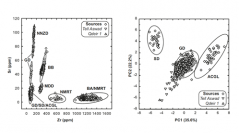

 Comptes Rendus Palevol
12 (3) - Pages 173-180
Comptes Rendus Palevol
12 (3) - Pages 173-180While obsidian sourcing has long represented a powerful means of reconstructing past socio-economic interaction, the use of destructive techniques restricted most studies to analysing only a few artefacts per site. Non-destructive methods allow the characterization of much more material, thus providing more robust data upon which to base our archaeological interpretations. Here we report on one such study using EDXRF and SEM-EDS to analyse assemblages from Tell Aswad and Qdeir 1, two Syrian Neolithic sites. The study demonstrates for the first time that SEM-EDS can play an important role in discriminating Bingöl A and Nemrut Dağ sources, while the rapidity of EDXRF permits the analysis of a more statistically valid number of artefacts, providing a better impression of the assemblage. It enabled us to chart diachronic patterns in raw material procurement at Tell Aswad and detailed raw materials not recorded in a previous smaller-scale analysis of obsidian from Qdeir 1.
Obsidian, Provenance studies, SEM-EDS, EDXRF, Non-destructive, Neolithic, Syria